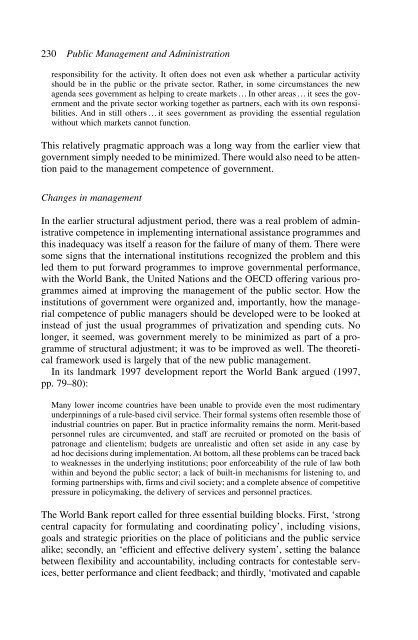Public Management and Administration - Owen E.hughes
Public Management and Administration - Owen E.hughes
Public Management and Administration - Owen E.hughes
Create successful ePaper yourself
Turn your PDF publications into a flip-book with our unique Google optimized e-Paper software.
230 <strong>Public</strong> <strong>Management</strong> <strong>and</strong> <strong>Administration</strong><br />
responsibility for the activity. It often does not even ask whether a particular activity<br />
should be in the public or the private sector. Rather, in some circumstances the new<br />
agenda sees government as helping to create markets … In other areas … it sees the government<br />
<strong>and</strong> the private sector working together as partners, each with its own responsibilities.<br />
And in still others … it sees government as providing the essential regulation<br />
without which markets cannot function.<br />
This relatively pragmatic approach was a long way from the earlier view that<br />
government simply needed to be minimized. There would also need to be attention<br />
paid to the management competence of government.<br />
Changes in management<br />
In the earlier structural adjustment period, there was a real problem of administrative<br />
competence in implementing international assistance programmes <strong>and</strong><br />
this inadequacy was itself a reason for the failure of many of them. There were<br />
some signs that the international institutions recognized the problem <strong>and</strong> this<br />
led them to put forward programmes to improve governmental performance,<br />
with the World Bank, the United Nations <strong>and</strong> the OECD offering various programmes<br />
aimed at improving the management of the public sector. How the<br />
institutions of government were organized <strong>and</strong>, importantly, how the managerial<br />
competence of public managers should be developed were to be looked at<br />
instead of just the usual programmes of privatization <strong>and</strong> spending cuts. No<br />
longer, it seemed, was government merely to be minimized as part of a programme<br />
of structural adjustment; it was to be improved as well. The theoretical<br />
framework used is largely that of the new public management.<br />
In its l<strong>and</strong>mark 1997 development report the World Bank argued (1997,<br />
pp. 79–80):<br />
Many lower income countries have been unable to provide even the most rudimentary<br />
underpinnings of a rule-based civil service. Their formal systems often resemble those of<br />
industrial countries on paper. But in practice informality remains the norm. Merit-based<br />
personnel rules are circumvented, <strong>and</strong> staff are recruited or promoted on the basis of<br />
patronage <strong>and</strong> clientelism; budgets are unrealistic <strong>and</strong> often set aside in any case by<br />
ad hoc decisions during implementation. At bottom, all these problems can be traced back<br />
to weaknesses in the underlying institutions; poor enforceability of the rule of law both<br />
within <strong>and</strong> beyond the public sector; a lack of built-in mechanisms for listening to, <strong>and</strong><br />
forming partnerships with, firms <strong>and</strong> civil society; <strong>and</strong> a complete absence of competitive<br />
pressure in policymaking, the delivery of services <strong>and</strong> personnel practices.<br />
The World Bank report called for three essential building blocks. First, ‘strong<br />
central capacity for formulating <strong>and</strong> coordinating policy’, including visions,<br />
goals <strong>and</strong> strategic priorities on the place of politicians <strong>and</strong> the public service<br />
alike; secondly, an ‘efficient <strong>and</strong> effective delivery system’, setting the balance<br />
between flexibility <strong>and</strong> accountability, including contracts for contestable services,<br />
better performance <strong>and</strong> client feedback; <strong>and</strong> thirdly, ‘motivated <strong>and</strong> capable











